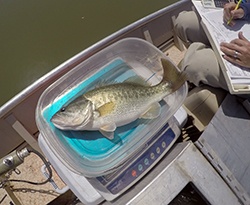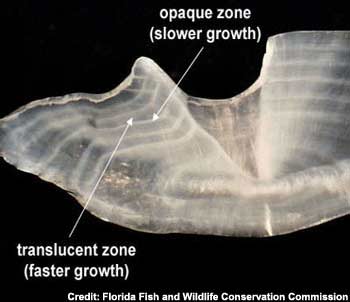Fisheries Management: How Old is Your Fish? Age and Growth.
May 1st, 2015
Written by Industry Expert Marc Harris, Fisheries Biologist
 How old a fish is relative to its length is an important indicator of fish health and growth. A well fed one year old fish in a healthy environment may be the same length as a two or three year old fish from a pond lacking sufficient forage. This kind of information in fisheries management is called length-at-age data. An older, shorter fish is called “stunted” and is often a part of a crowded population. Thankfully, the fish itself provides the information needed to determine just how old it is.
How old a fish is relative to its length is an important indicator of fish health and growth. A well fed one year old fish in a healthy environment may be the same length as a two or three year old fish from a pond lacking sufficient forage. This kind of information in fisheries management is called length-at-age data. An older, shorter fish is called “stunted” and is often a part of a crowded population. Thankfully, the fish itself provides the information needed to determine just how old it is.
Aging fish is nearly identical to aging a tree. Like a tree, fish are always producing layers of growth. The two primary ways to age fish is to either examine scales from the fish or to examine one of the otolith’s (inner ear bones). During times of slow growth, such as in winter for warm water fish, the layers of growth in these structures are closer together and form a dark line (annuli, for annual rings). In the summer when fish are growing more quickly, these layers of growth are spread out resulting in a lighter area.
Scales are the most common part used for aging fish in northern climates. They are easily collected and taking a few scales does not harm the fish. Under a microscope you can count the annuli to see how old the fish is. Not only that, but how far apart the rings are shows how much the fish grew each year of its life. Although aging fish with scales is relatively easy, it is not the most accurate method.
 Otoliths are often called the “ear bones” of a fish. They are hard structures made of calcium carbonate located in the head of most fish. Just like in human ears, otoliths help fish with their balance, orientation, and their “hearing”. Each fish has three pairs of otoliths and each species of fish has different looking otoliths. Otolith is the most accurate way to age a fish.
Otoliths are often called the “ear bones” of a fish. They are hard structures made of calcium carbonate located in the head of most fish. Just like in human ears, otoliths help fish with their balance, orientation, and their “hearing”. Each fish has three pairs of otoliths and each species of fish has different looking otoliths. Otolith is the most accurate way to age a fish.
Knowing how old your fish are can play an important role in future fisheries management strategies. Not only that, but another important part of this aging process is the ability to complete back calculations and determine how large the fish was each year of its life. This allows fisheries managers to look back in time and gain an accurate understanding of the fisheries’ recent history. This information can provide an accurate timeline of how the fishery reached its current state and can provide valuable insight when designing a fisheries management strategy to improve fish growth rates.
Contact a fisheries biologist if you are interested in determining the age of fish in your pond.
Find Your Fisheries Management Solution
Free Report: 6 Reason to Invest in a Fisheries Management Company
Contact the experts at 888-480-5253 for all of your lake, pond and fisheries management needs.
Marc Harris is a Fisheries Biologist with SOLitude Lake Management. Since 1998, SOLitude Lake Management has been committed to providing full service lake and pond management services that improve water quality, preserve natural resources, and reduce our environmental footprint. Services are available throughout the Eastern United States. Fisheries management consulting and aquatic products are available nationwide. Learn more about SOLitude Lake Management and purchase products at www.solitudelakemanagement.com.










